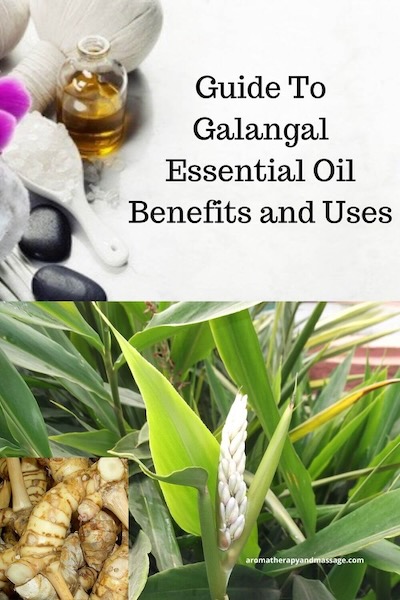- Home
- Essential Oil Profiles
- Galangal Essential Oil
As an affiliate for Bookshop, Amazon, and other programs, I may earn a small commission for products purchased through links. This doesn't affect the price you pay. Privacy policy and disclosures.
Search this site:
Guide to Galangal Essential Oil Benefits and Uses
Aromatherapy uses two types of galangal essential oil:
- Lesser galangal (Alpinia officinarum Hance), also known as Chinese ginger
- Greater galangal (Alpinia galanga), also known as Siam ginger or Thai ginger
You may also see the spelling galanga.

Plant family: Zingiberaceae
Production: Steam distilled from fresh rhizomes (roots) of the plant.
Aroma: Fresh, spicy-camphoraceous.
Perfume/Aromatic note: Middle
Is galangal safe to use during pregnancy? Probably not. Consult a professional.
Is galangal essential oil safe for children? Do not apply lesser galangal on or near the faces of infants and young children due to the high 1,8-cineole content. Some sources indicate not to use lesser galangal with children under age six.
Cautions: None known for greater galangal.
Main components
Greater galangal:
- 1,8-cineole 30.2–33.6%
- camphor 5.0–14.0%
- beta-pinene 0.9–12.9%
Lesser galangal:
- 1,8-cineole 49.6%
- beta-pinene 6.6%
- alpha-pinene 5.8%
Only the Alpinia genus produces true galangal oil—don't confuse the true oil with false galangal from Kaemferia galangal, which is also called maraba. The primary components of that oil are ethyl (E)-p-methoxycinnamate, pentadecane, and (E)-ethyl-cinnamate.
Source: Essential Oil Safety, 2nd Edition
Galangal Essential Oil Benefits and Uses
The Encyclopedia of Essential Oils (updated edition): Galangal may help relieve digestive upsets. The oil blends well with citrus oils, allspice, chamomile maroc, cinnamon, lavandin, myrtle, patchouli, pine needle, opopanax, rosemary, and sage.
Essential Oils: A Comprehensive Handbook for Aromatic Therapy: Greater galangal may help relieve pain and inflammation, fight microbes, dilate the bronchi, and thin mucus. Indications for the oil include musculoskeletal aches and pains, respiratory congestion, and as a skin antiseptic when combined in a ratio of 3 parts galangal to 7 parts lemongrass essential oil. For digestive support, you could make an abdominal massage oil by combining galangal with oils such a caraway seed, coriander seed, bitter orange, lime, or lavender in a carrier oil. (p. 649)
The Complete Guide to Clinical Aromatherapy by Elizabeth Ashley: Greater galangal may help relieve upset stomach and nausea. This warming oil is an aphrodisiac and may help regulate periods. Avoid during pregnancy.
The Complete Guide to Aromatherapy, Third Edition, Vol. 1: Energetically, galangal is warming and helps dispel cold conditions associated with the digestive or respiratory system. In Traditional Chinese Medicine, the essential oil stimulates the Yang Qi of the kidney, potentially helping relieve low back pain associated with muscle fatigue. The oil also strengthens the Zhi, which is responsible for willpower and determination.
Suggested essential oils to blend with galangal:
- To relieve indigestion: caraway seed, coriander seed, sweet fennel, ginger, sweet orange, peppermint, or rosemary.
- To relieve muscle and joint aches and pains: bay laurel, black pepper, clove, lemon eucalyptus, ginger, kunzea, spike lavender, pine, or rosemary.
- To relieve physical and emotional exhaustion: basil, bay laurel, cardamon, lemon, lemongrass, lime, peppermint, pine, or rosemary.
Nature in Bottle: Galangal helps relax nerves and inspire creativity, especially during situational anxiety and depression. The oil may increase intuition and amplify psychic abilities. The oil's scent may be an aphrodisiac.
Aromatherapy and Subtle Energy Techniques: Use galangal for the third (solar plexus) chakra to help personal will become balanced and healthy and to promote personal integrity.
Essential Oils in Spiritual Practice: Galangal essential oil is a catalyst for seeing synchronicities and benefiting from them. The oil supports the first (root) and second (sacral) chakras. Use this essential oil to support completing projects, to help develop talent, and to come into alignment with beneficial circumstances. See the book for more details, including using the oil with archetypes.
Mixing Essential Oils for Magic: Use galangal for astral and psychic work. The oil aids and increases the success of spells and protects during magic and healing work. The essential oil is associated with longevity, secrets, stability, strength, and well-being and can help attract money, overcome injustices, and turn wishes into reality.
Diffuser Blend to Relieve Fatigue
- 3 drops galangal
- 3 drops lime essential oil
- 2 drops rosemary essential oil
Massage Blend to Relieve Indigestion and Gas
- 2 drops galangal
- 2 drops roman chamomile essential oil
- 2 drops lavender essential oil
- 1 teaspoon carrier oil
Massage the blend onto your abdomen in a gentle clockwise motion and on the chest moving towards the heart.
Massage Blend to Ease Stiff Muscles & Joints
- 3 drops galangal essential oil
- 2 drops cinnamon essential oil
- 1 drop lavender essential oil
- 1 teaspoon carrier oil
Massage blend into the affected area.
Adapted from Base Formula.
Buy essential oils from Aromatics International (recommended).
Rocky Mountain Essential Oils.
Photo Credit: Roots – Susan Slater, CC BY-SA 4.0, via Wikimedia Commons. Plant – Yercaud-elango, CC BY-SA 4.0, via Wikimedia Commons.



